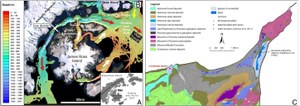Popular Science: Erratic boulders – witnesses of the past
Antarctica was more glaciated in the past than it is now. The irregular decline began between 15 and 8 ka BP along the whole Antarctic seashore. Nowadays the decline is faster. At the time of the biggest extension of glaciation, the Prince Gustav Ice Stream drained the glacier mass to the sea shelf near the eastern coast of the Antarctic Peninsula. The scientists used dating methods to investigate when the ice stream retreated from the northern part of James Ross Island.
Erratic boulders were dated. These are fractions of rock originating in another place and transported by glacier to a new locality. The cosmogenic exposure dating method was used to find how long a boulder was exposed and thus not covered by a glacier. The dating is based on cosmogenic nuclides, which are produced from the first moment the surface is exposed. The second method used in this research is based on measurements of rock hardness. Thanks to this method, the authors can estimate how long a boulder has been exposed to weathering processes and allows comparisons of tested boulders according to their relative age.
 Source: The original paper
Source: The original paper
According to the results at the study site on the northern part of James Ross Island, the glaciers started retreating circa 13 ka BP. Between 13 and 11 ka BP the glaciers were affected by increasing temperatures, but between 11 and 9 ka BP this changed to cooling. The temperature decrease slowed the retreat of the glaciers, but the warming after that led to the deglaciation of the study site at about 8.6 ka, including the highest part 110 metres above sea level. Higher temperatures persisted and deglaciation continued in the higher parts of the island. In the Holocene era the glacier retreat was interrupted several times by its growth. The last similar event was the “small ice age” between the 14th and 19th centuries.
The results show that modern methods help us to find more from witnesses of the past and it gives us lessons for today, when temperature changes are once again influencing how the Earth will look in the future.
Tomáš JANÍK
Document Actions